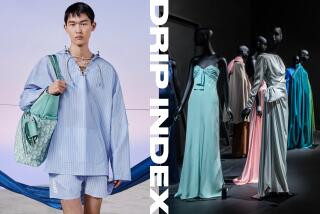Looking for the Big Time
A Santa Ana watch company has created a line of women’s watches designed to buy endangered species more time.
Last year, Ibis International introduced three watch collections to draw attention to the plight of the poison dart frog, scarlet macaw, snowy owl and other creatures threatened with extinction. The collections are named for endangered habitats: the Rainforest, Arctic and Great Barrier Reef.
Whether in color, imagery or namesake, each watch is inspired by a species indigenous to one of the habitats. They’re timepieces with an environmental tick.
“Some people hear the word ‘environmental’ and think, ‘Is the watch made of bark?’ ” says Daniel Lyons, Ibis’ vice president.
In fact, styles are more reminiscent of Gucci and Giorgio than granola. They do bear on the face the name or likeness of animals, birds and marine life, including the beluga whale. The Rainforest Collection has several styles adorned with sculptured images of jaguars, macaws and other creatures clinging to the bangle-style bands.
Combining fashion with an environmental focus has long been the dream of Gloria Johnson Lytle, Ibis’ CEO and director of design, who moved from Orange County to Maui two years ago.
“I’ve been an environmentalist all of my life. I fell in love with nature when I was a child,” Johnson Lytle says. “My mother would take us to the tide pools in Laguna Beach. We’d watch Audubon movies and read Time-Life nature books, and as I got older I became aware of the destruction of animal habitats.”
Johnson Lytle, formerly the primary designer for Giorgio Beverly Hills Timepieces, has combined her design and art experience with her concern for animals. She developed packaging for each of the three Ibis collections that features a multicolored mosaic of 16 threatened species; each watch comes in a canvas pouch printed with the pattern.
Ibis’ watch designs are as colorful as the keel-billed toucan of the Rainforest or the corals that inhabit the Great Barrier Reef.
“A lot of people think of something environmental as gloomy or ugly. We wanted to show that these could be pretty, while raising people’s awareness,” Johnson Lytle says.
Using a special enameling process, Ibis colors the bands, dials and bezels in colors found in nature but not usually found in watches.
The dressy watches in the Rainforest Collection have jewel-toned bangles, including a pearly green that looks like jade, a Bougainvillea red and metallic Egyptian blue. Sports watches in the Great Barrier Reef Collection have link bands painted in all the hues of the deep; the casual Arctic Collection has metal bands and dials in cool, icy shades.
“We’re trying to bring color into watches,” Lyons says. “Before, you’d see just gold or silver or two tones. There were few options, other than changing the [colored] bezels. Our sport series can match bikinis or workout clothes. We had a woman buy our green bangle watch to match her shoes.”
Ibis can color its watches in more than 50 choices of enamel. The timepieces change hues with the fashion seasons.
Because of their colors, the watches have become a hit on TV. They’ve been worn by characters on “Cybil,” “Ally McBeal,” “Sister Sister,” “Sabrina,” “Clueless,” “The Larry Sanders Show” and “Moesha.”
Despite such exposure for the line, making the leap from small company to name brand has proved a challenge. Ibis president Donald Gavin, who worked for Giorgio Timepieces with designer Johnson Lytle, developed the idea for a colorful, environmentally themed watch line two years ago.
Ibis chose an environmental motif to separate the line from the competition.
They named the line after the ibis, a wading, heron-like bird worshiped by ancient Egyptians and that symbolized the god Toth, creator of time. Certain species of the ibis are extinct, while others, such as the red scarlet ibis, are endangered, making the bird a fitting image.
“We have to be different. We can’t be another Calvin Klein,” Lyons says.
To break into mainstream department store chains, Ibis must take on the likes of Calvin Klein and Guess?, companies with established images, for valuable retail space. Lyons has been showing the line to buyers for the huge chains, but many don’t like to take chances on newcomers. That makes it tough for anything but familiar name brands “to get on the dance floor,” Lyons says.
“You have the same merchandise at every store across the country,” he says. “Corporate buyers don’t want to test things out. They’re afraid to make a mistake. It’s a Catch-22. You have small companies that bring a very unique product, but where do they go? We’re making our hay with unique boutiques and catalogs.”
Ibis is carried at about 75 jewelry stores, boutiques and specialty shops throughout the U.S., including the Swiss Connection in Laguna Niguel, and through catalogs such as Bloomingdale’s.
The company has a Web site (www.IBISwatches.com) that describes the species featured on the watches.
The watches retail for $55 to $95; 10% of profits will be donated to environmental causes--once Ibis starts turning a profit, Gavin says. Ibis is considering the national Rainforest Action Network and the national Nature Conservancy as its beneficiaries.
“Their heart is in the right place,” says June Freiwald, a Monterey-based environmentalist who handles product development for the Pacific Whale Foundation, an nonprofit ocean-conservation organization that has a marine resource center and retail store in Maui.
Freiwald added Ibis watches to the store’s assortment of ocean-related merchandise, she said, because she liked the company’s commitment to environmental causes and she liked the watches’ ocean-inspired colors. At her suggestion, Ibis added a dolphin watch. Visitors to the center “just love it,” Freiwald says.
Ibis hopes that, even if a woman doesn’t have a save-the-whale sticker on her car bumper, she’ll want a watch because of the colorful designs. The company is expanding styles but has no plans to launch a men’s line. As Lyons says, “Men are not color mavens.”






